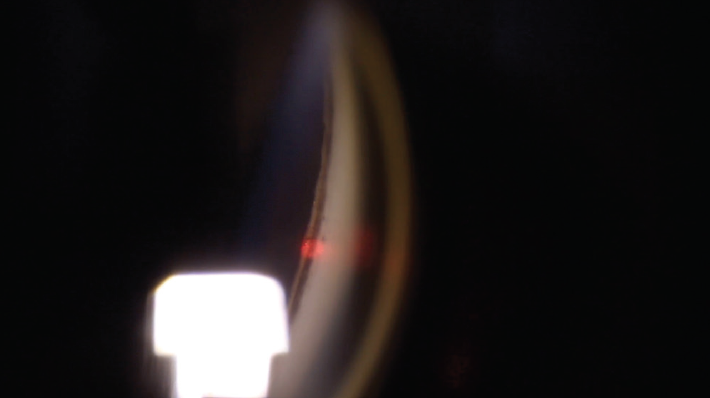
For over 15 years, we have performed selective laser trabeculoplasty (SLT) as a safe, effective primary and adjunct treatment to lower IOP for patients with glaucoma.1,2 Now, we are beginning to learn that when we use SLT as a first-line therapy, we not only reduce IOP, but we might also gain diagnostic information about the source of a patient’s outflow resistance. This is an exciting concept, as our perception of this trusted method for reducing patients’ burden of medications evolves to include a key role in glaucoma management, particularly in the age of microinvasive glaucoma surgeries (MIGS).
The shift from ocular hypertensive medications to other early interventions has followed disturbing data about medication use. Adherence in the first year is 51% to 56%, according to one study,3 but other reports say the reality is even lower.4 Patients might simply forget to take drops, but discomfort is a factor as well. Toxicity is a risk for virtually all topical glaucoma medications,5 including newer prostaglandins.6-8 Local side effects such as burning, dryness, conjunctival hyperemia, watering, and foreign body sensation grow worse with use over time.9 Systemically, these medications can exacerbate existing airway pathology10 and may impact patients with high blood pressure or diabetes.11 Procedures such as SLT offer the option to help control IOP safely while minimizing issues of compliance and side effects long term.
SLT as First-line Therapy
Prostaglandins have been the first-line therapy for glaucoma for many years. It is only recently, with abundant data about noncompliance and the advent of new MIGS options, that we have taken a step back from standard therapy to consider surgical solutions as first-line tools.
Several key studies have assessed SLT as a first-line therapy. One prospective study showed that SLT reduced IOP 30% when used as a first treatment,12 and a long-term study found that SLT patients’ IOP was reduced 24.3%, 27.8%, 24.5%, and 29.3% at years 1, 2, 3, and 4.13 Studies comparing SLT to prostaglandin found it to be a safe alternative for primary glaucoma therapy, with similar outcomes and far less need for additional therapies in the first year.14,15 In one study, SLT lowered IOP by 6.6 mm Hg (29.9%), compared to 5.58 (25.4%) with prostaglandin.16 Studied side by side with latanoprost, SLT reduced IOP at least 20% in 75% of eyes, compared to 73% of eyes for latanoprost.17
Clearly, evidence shows that SLT lowers IOP similarly to topical medication. Patients can have the same benefits of medication without the uncomfortable side effects or, most importantly, the compliance issues that threaten their safe management of glaucoma.18 The procedure is even more cost-effective than long-term medication use.19
In my experience, SLT and MIGS are attempting to achieve the same outcomes: decrease drop burden, help bring IOP down to a target range, and maintain or help improve quality of life. In fact, SLT is a “noninvasive glaucoma procedure." It has a very good risk/benefit profile and targets the trabecular meshwork, which is targeted by some MIGS devices as well.
SLT’s Diagnostic Value
When we use SLT as a first-line therapy, IOP-lowering effect is equivalent to medication, but we also may gain a secondary benefit of diagnostic information. Unfortunately, there are no preoperative noninvasive diagnostic tools to provide us the exact location of outflow resistance, but SLT might be a way to at least point us in the right direction.
In SLT, we apply selective photothermolysis to pigmented cells in the trabecular meshwork, which releases inflammatory mediators, such as macrophages and cytokines. This increases aqueous outflow through the trabecular meshwork and the inner wall of Schlemm canal. When SLT has a significant effect, we assume the trabecular meshwork could be the main area of resistance. When it is not effective, this might tell us that resistance is in the canal or in the distal collector channels.
We are only beginning to explore the potential diagnostic benefit of SLT as a first-line therapy. It is intriguing to think that if it does help us understand a patient’s pathology, we possibly can use that information to select the best MIGS intervention for a given patient.
I began to suspect that SLT had diagnostic value when I noted that patients who responded to SLT historically (Figure) also did well with subsequent implantation of the iStent Trabecular Micro-Bypass Stent (Glaukos) during cataract surgery, whereas those who did not respond to SLT tended to demonstrate less response to the iStent. My thought is if SLT works well, then the trabecular meshwork might be the major cause of resistance in the natural outflow pathway. If SLT does not demonstrate a significant response, I assume the major site of resistance is likely to be in the canal or distal. For cases where SLT works well, a trabecular bypass procedure like iStent would be a good choice. If SLT does not have an effect, a canal-based procedure such as ab interno canaloplasty (ABiC; Ellex) using the iTrack device (Ellex) may be a better option to open up all of the natural outflow pathways, such as Schlemm canal and collector channels as well as the trabecular meshwork.

Figure. A patient after SLT.
Although I have seen these trends in our patient population, larger, longitudinal, comparative studies are needed to help fully understand the potential diagnostic role of SLT. At this time, considering the lack of alternative diagnostic tools to help guide our decisions for the “right MIGS device” for each patient, I do think there is potential value in using SLT as another piece of information to help us make the best decisions for our patients.
ABiC and iTrack are trademarks of Ellex. © Ellex 2017. All other brand/product names are the trademarks of their respective owners.
1. Li X, Wang W, Zhang X. Meta-analysis of selective laser trabeculoplasty versus topical medication in the treatment of open-angle glaucoma. BMC Ophthalmol. 2015;15:107.
2. Wong MO, Choy BN. Systematic review and meta-analysis on the efficacy of selective laser trabeculoplasty in open-angle glaucoma. Surv Ophthalmol. 2015;60(1):36-50.
3. Sheer R, Bunniran S, Uribe C, et al. Predictors of nonadherence to topical intraocular pressure reduction medications among Medicare members: a claims-based retrospective cohort study. J Manag Care Spec Pharm. 2016;22(7):808-817.
4. Joseph A, Pasquale LR. Attributes associated with adherence to glaucoma medical therapy and its effects on glaucoma outcomes: an evidence-based review and potential strategies to improve adherence. Semin Ophthalmol. 2017;32(1):86-90.
5. Robciuc A, Witos J, Ruokonen SK, et al. Pure glaucoma drugs are toxic to immortalized human corneal epithelial cells, but they do not destabilize lipid membranes. Cornea. 2017;36(10):1249-1255.
6. Baudouin C, Riancho L, Warnet JM, Brignole. In vitro studies of antiglaucomatous prostaglandin analogues: travoprost with and without benzalkonium chloride and preserved latanoprost. Invest Ophthalmol Vis Sci. 2007;48(9):4123-4128.
7. Baudouin C, Liang H, Hamard P, et al. The ocular surface of glaucoma patients treated over the long term expresses inflammatory markers related to both T-helper 20. 1 and T-helper 2 pathways. Ophthalmology. 2008;155(1):109-115.
8. Jaenen N, Baudouin C, Pouliquen P, et al. Ocular symptoms and signs with preserved and preservative-free glaucoma medications. Eur J Ophthalmol. 2007;17(3):341-349.
9. Chawla A, McGalliard JN, Batterbury M. Use of eyedrops in glaucoma: How can we help to reduce non-compliance? Acta Ophthalmol Scand. 2007;85(4):464.
10. Roughead EE, Kalisch LM, Pratt NL, et al. Managing glaucoma in those with co-morbidity: not as easy as it seems. Ophthalmic Epidemiol. 2012;19(2):74-82.
11. Lin HC, Chien CW, Hu CC, Ho JD. Comparison of comorbid conditions between open-angle glaucoma patients and a control cohort: a case-control study. Ophthalmology. 2010;117(11):2088-2095.
12. Melamed S, Simon GJB, Levkovitch-Verbin H. Selective laser trabeculoplasty as primary treatment for open-angle glaucoma. Arch Opthalmol. 2003;121(7):957-960.
13. Katz LJ, Steinmann WC, Kabir A, et al. Selective laser trabeculoplasty versus medical therapy as initial treatment of glaucoma: a prospective, randomized trial. J Glaucoma. 2012;21(7):460-468.
14. Katz LJ, Steinmann WC, Kabir A, et al; SLT/Med Study Group. Selective laser trabeculoplasty versus medical therapy as initial treatment of glaucoma: a prospective, randomized trial. J Glaucoma. 2012;21(7):460-468.
15. Freitas AL, Ushida M, Almeida I, et al. Selective laser trabeculoplasty as an initial treatment option for open-angle glaucoma. Arq Bras Oftalmol. 2016;79(6):417-421.
16. Alvarado JA, Iguchi R, Martinez J, et al. Similar effects of SLT and prostaglandin analogs on the permeability of cultured Schlemm canal cells. Am J Ophthalmol. 2010;150(2):254-264.
17. Nagar M, Ogunyomade A, O’Brart DP, et al. A randomised, prospective study comparing SLT with latanoprost for the control of intraocular pressure in ocular hypertension and open angle glaucoma. Br J Ophthalmol. 2005;89(11):1413-1417.
18. Kadasi LM, Wagdi S, Miller KV. Selective laser trabeculoplasty as primary treatment for open-angle glaucoma. R I Med J. 2013;99(6):22-25.
19. Leahy KE, White AJ. Selective laser trabeculoplasty: current perspectives. Clin Ophthalmol. 2015;9:833-841.
